The Chubut Province in Argentina is home to many birds, from giant, soaring eagles to tiny hummingbirds. The province is located in the southern part of the country, and the varied terrain and temperate climate provide ideal conditions for a range of bird species.
The vast Patagonian steppe is home to many grassland birds, while the Andean foothills contain species adapted to alpine environments. The province also has an abundance of wetlands, home to several species of waterfowl.
The Chubut Province is a paradise for bird watchers, as its diverse habitats make it a great place to observe various species.
37 Birds to Watch in Chubut Province
If you are a bird lover and you are planning to visit Argentina, you should not miss the Chubut Province in the southern part of the country. This province is a paradise for bird watchers, as it has a diverse range of habitats and climates that host a variety of bird species.
Here are 37 birds that you should watch in Chubut Province.
1. Elegant Crested Tinamou
The crested tinamou, also known as the martineta tinamou, is a unique bird species in southern Chile and Argentina. It is a medium-sized bird, generally measuring between 30 and 35 cm in length, with a distinct crest of feathers on its head.
This species is predominantly terrestrial, has poor flying ability, and resides in shrubland habitats. The crested tinamou has an omnivorous diet consisting of animal and plant material.
It mainly feeds on insects, spiders, snails, and other invertebrates and consumes fruits, seeds, and grains.
Its diet is varied and seasonal, depending on the food availability in its natural environment. The crested tinamou is an important species to local ecosystems as it plays a role in seed dispersal and soil aeration.
Its presence in the shrubland is also beneficial for other species, as it helps to control insect populations that would otherwise damage the vegetation. The crested tinamou is a unique and fascinating species native to southern Chile and Argentina.
Its terrestrial lifestyle and omnivorous diet are essential components of the local ecosystems, and its presence helps to maintain a healthy environment for the plants and animals that share its habitat.
| Kingdom | Animalia |
| Phylum | Chordata |
| Class | Aves |
| Order | Tinamiformes |
| Family | Tinamidae |
| Genus | Eudromia |
| Species | E. elegans |
2. Austral Pygmy Owl
The austral pygmy owl is a species of small owl found in South America. It belongs to the Strigidae family, composed of owls known for their distinct hooting calls.
The species is mainly found in Argentina and Chile, although it may occasionally be spotted in other parts of the region. The austral pygmy owl is a relatively small species of owl, measuring about 12–14 cm in length and weighing only around 40–50 grams.
It has a rounded head, a short, stout bill, pale underparts, and a greyish-brown upper body. Its eyes are yellow-orange, and its wings are relatively short.
The austral pygmy owl is an elusive species and is usually active at night when it hunts for small mammals, birds, lizards, and insects. Its habitat includes dry and open woodlands, grasslands, and savannas.
The species is listed as “Near Threatened” on the IUCN Red List due to habitat loss and fragmentation. Conservation efforts are needed to ensure the survival of this species.
| Kingdom | Animalia |
| Phylum | Chordata |
| Class | Aves |
| Order | Strigiformes |
| Family | Strigidae |
| Genus | Glaucidium |
| Species | G. nana |
3. Great Grebe
The Great Grebe is a species of bird that is found throughout the world. It is the largest species of grebe and has a disjunct population in northwestern Peru. The main distribution of the Great Grebe is from extreme southeastern Brazil to Patagonia and central Chile.
This population from southern Chile is considered a separate subspecies known as P. m. navasi. This subspecies can be distinguished from the other populations of Great Grebes by its unique physical features.
The Great Grebe is an impressive bird with its long neck and bright orange-red throat patch. It is typically found in freshwater wetlands, and its diet consists of small fish and aquatic invertebrates.
The Great Grebe is an important species to the local environment as it plays an essential role in the food web.
| Kingdom | Animalia |
| Phylum | Chordata |
| Class | Aves |
| Order | Podicipediformes |
| Family | Podicipedidae |
| Genus | Podiceps |
| Species | P. major |
4. Brown-hooded Gull
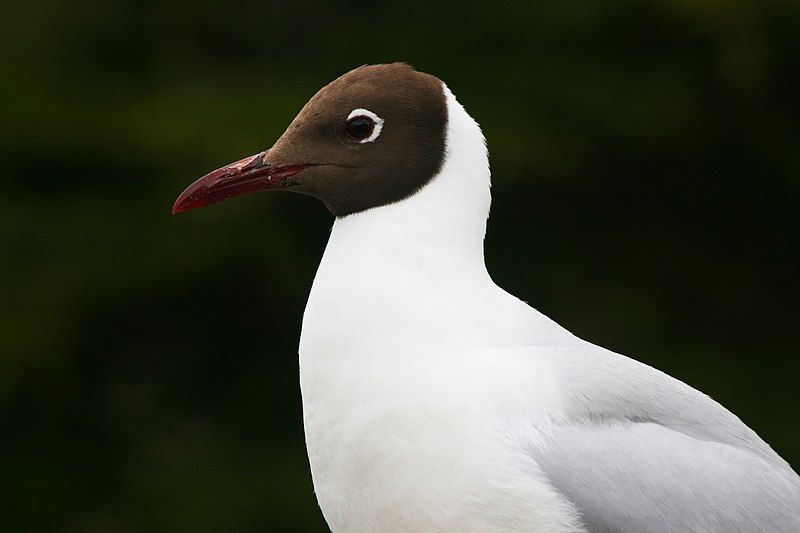
The brown-hooded gull is a species of gull found in many South American countries, including Argentina, Brazil, Chile, the Falkland Islands, and Uruguay. It is classified by its specific epithet, maculipennis, which means ‘spotted wings’ in Latin.
This species of gull is recognizable by its white body, brown head, and distinctive red beak and feet. The brown-hooded gull feeds on fish, crustaceans, and small invertebrates such as mollusks and worms.
It is considered a common bird species and can be found in open coasts, lagoons, estuaries, grasslands, and farmland. While they are not migratory, they will sometimes move from one area to another.
The brown-hooded gull is an essential bird species in South America and a vital part of the region’s ecosystem.
| Kingdom | Animalia |
| Phylum | Chordata |
| Class | Aves |
| Order | Charadriiformes |
| Family | Laridae |
| Genus | Chroicocephalus |
| Species | C. maculipennis |
5. Patagonian Mockingbird
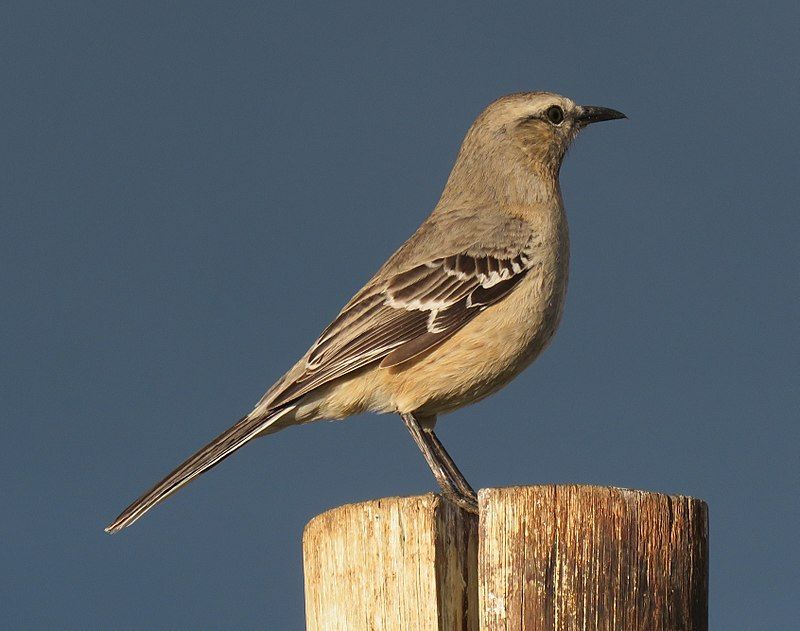
The Patagonian mockingbird is a species of bird found primarily in Argentina, with a smaller population in Chile. It is a member of the Mimidae family, which includes about 40 bird species in the Americas.
The Patagonian mockingbird is a small bird, typically measuring 9 and 10 inches long, with gray and white plumage and a black tail. It can be found in various habitats, including grasslands, shrublands, and woodlands.
The Patagonian mockingbird is omnivorous, feeding on various insects, fruits, and seeds. It is known for its distinct call, which includes a variety of whistles, trills, and chatters.
It is often seen perched on high, exposed branches, from which it can survey its surroundings. The Patagonian mockingbird is not considered a threatened species, as its population is stable.
| Kingdom | Animalia |
| Phylum | Chordata |
| Class | Aves |
| Order | Passeriformes |
| Family | Mimidae |
| Genus | Mimus |
| Species | M. patagonicus |
6. Buff-winged Cinclodes
The buff-winged cinclodes is a bird species belonging to the Furnariidae family. It is native to Argentina and eastern Chile and migrates to the Pampas region during winter.
This species was formerly considered the nominate subspecies of the bar-winged cinclodes. The buff-winged cinclodes is a medium-sized bird, typically growing to about 8 inches long with a wingspan of approximately 12 inches.
Its back is grayish, mainly brown, with a buff or pale yellowish-orange underside and wings. It has a black-and-white striped face and a short, curved bill. The buff-winged cinclodes are terrestrial species typically found in open grasslands and shrublands.
It feeds mainly on insects and other small invertebrates. Breeding season for the buff-winged usually includes spring, from September to December. The female will lay a clutch of two to three eggs in a shallow depression lined with grasses and small twigs.
The eggs will hatch after an incubation period of about 14 days. The young birds will fledge after about 22 days.
| Kingdom | Animalia |
| Phylum | Chordata |
| Class | Aves |
| Order | Passeriformes |
| Family | Furnariidae |
| Genus | Cinclodes |
| Species | C. fuscus |
7. Southern Martin
The southern martin is a species of bird from the family Hirundinidae. It is native to the regions of Argentina and southern Bolivia. During winter, it migrates to the western Amazon Basin, which is located in South America.
This species of bird is known for its small size and dark plumage. Its wings are black with white patches, and its tail is somewhat forked.
It also has a distinctive call, a complex, metallic chirping. The southern martin feeds primarily on insects, such as grasshoppers, crickets, and caterpillars. It is an active bird hovering over fields and meadows for food.
It also eats small fruits and occasionally small vertebrates such as lizards and frogs. The southern martin is a social bird that often gathers in large groups when migrating.
During the breeding season, the male southern martin performs elaborate displays that involve flying in circles and singing loudly. The female typically builds a small nest in a hole in a tree or a crevice in a rock.
The nest is usually lined with feathers and other soft materials. The southern martin is an essential species in its range as it is a significant insect predator and helps control insect populations.
It is also an important bird for birdwatchers, as seen in its winter and breeding grounds.
| Kingdom | Animalia |
| Phylum | Chordata |
| Class | Aves |
| Order | Passeriformes |
| Family | Hirundinidae |
| Genus | Progne |
| Species | P. elegans |
8. Black-faced Ibis
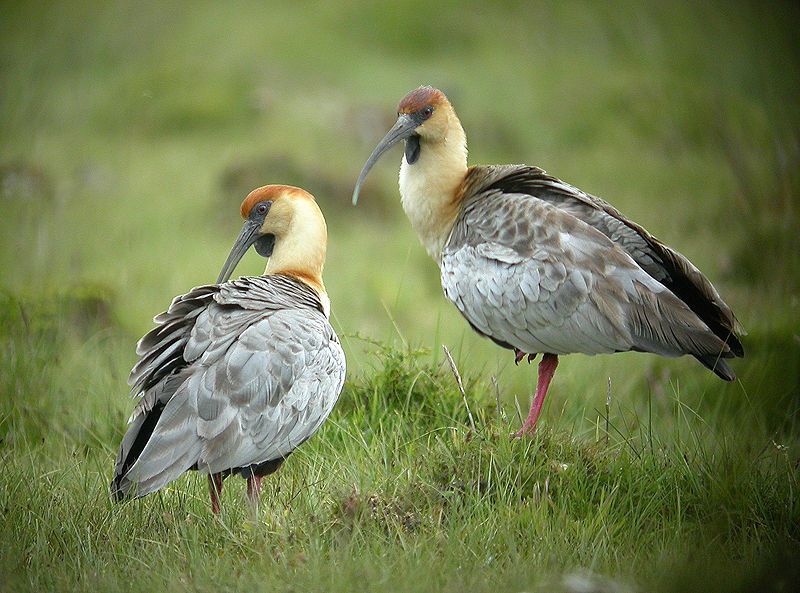
The black-faced ibis is a species of bird belonging to the family Threskiornithidae. It is native to the grasslands and fields of southern and western South America. In the past, this species was considered a subspecies of the buff-necked ibis.
However, after further research, it has been determined that the two species are distinct enough to be separated, and this is the accepted view by most significant authorities.
The black-faced ibis is a large bird, measuring up to 70 cm in length, and is mainly black with a white head. It has a long, curved bill and a long, decurved neck. Its wings are broad and rounded, and its tail is long and wedge-shaped.
It feeds mainly on small insects, worms, and other invertebrates but also consumes some small vertebrates such as frogs or lizards. It typically forages in small groups and is often seen in open grasslands or wetlands.
| Kingdom | Animalia |
| Phylum | Chordata |
| Class | Aves |
| Order | Pelecaniformes |
| Family | Threskiornithidae |
| Genus | Theristicus |
| Species | T. melanopis |
9. Silvery Grebe
The silvery grebe is a unique species of bird found in the western and southern parts of South America. It is known to inhabit habitats up to 4,000 meters in altitude, making it a rather impressive bird. It prefers freshwater lakes, but it can also feed in saline lakes.
This creature has a unique adaptation to its environment, which allows it to survive in such high altitudes. Its natural habitat is freshwater lakes, but its ability to feed in saline lakes makes it one of the few birds that can inhabit such a wide range of environments.
This grebe species is part of the family Podicipedidae, which includes other species of grebes. Its silvery feathers are a distinguishing feature, giving it its name.
This grebe species is an incredible creature, with an impressive adaptation to its environment, allowing it to survive in such high altitudes.
| Kingdom | Animalia |
| Phylum | Chordata |
| Class | Aves |
| Order | Podicipediformes |
| Family | Podicipedidae |
| Genus | Podiceps |
| Species | P. occipitalis |
10. Flying Steamer Duck
The flying steamer duck is a unique species found in South America. It is scientifically classified as an Anatidae family member, comprising all waterfowl, including geese, swans, and ducks.
A few other names, such as the flying steamer duck or flying steamer duck, also known as the flying steamer duck. This duck is a medium-sized waterfowl measuring 35 and 37 centimeters in length. It has a wingspan of up to 55 centimeters and weighs up to 0.7 kilograms.
Its plumage is mainly brown, with a white breast and patch on its throat. The flying steamer duck prefers to inhabit marshlands, lagoons, and rivers, feeding primarily on aquatic plants, insects, and larvae.
It is a solid and agile flier, reaching up to 70 kilometers per hour. The flying steamer duck is a relatively common species and is not considered to be threatened.
| Kingdom | Animalia |
| Phylum | Chordata |
| Class | Aves |
| Order | Anseriformes |
| Family | Anatidae |
| Genus | Tachyeres |
| Species | T. patachonicus |
11. Grey-hooded Sierra Finch
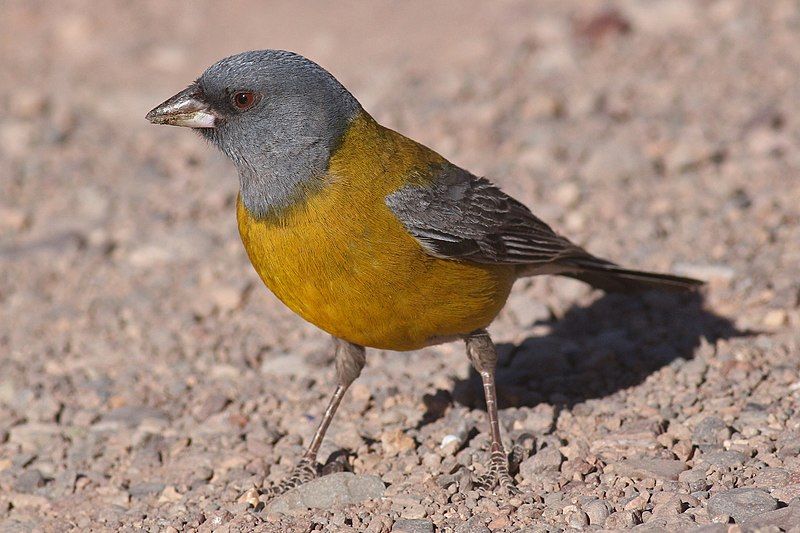
The grey-hooded Sierra finch is a bird species in the family Thraupidae, a group of brightly colored, mainly seed-eating birds.
This particular species is found in the wild in Argentina and Chile, where its natural habitats include subtropical or tropical dry shrubland and subtropical or tropical high-altitude shrubland.
These two habitats are distinct in terms of vegetation and altitude.
The subtropical or tropical dry shrubland is characterized by a dry climate lacking vegetation, while a higher altitude and more vegetation characterize the subtropical or tropical high-altitude shrubland.
This finch species is well adapted to its environment, where it can find food and shelter in the dry shrubland and more protective terrain in the high-altitude shrubland.
The grey-hooded Sierra finch is a unique bird species, and its presence in Argentina and Chile helps create a diverse and vibrant ecosystem.
| Kingdom | Animalia |
| Phylum | Chordata |
| Class | Aves |
| Order | Passeriformes |
| Family | Thraupidae |
| Genus | Phrygilus |
| Species | P. gayi |
12. Chubut Steamer Duck
The Chubut steamer duck is a species of duck natively found in Argentina. It is also known as the white-headed flightless steamer duck because of its distinct white head. This species of steamer duck is unique because it is flightless, meaning it cannot fly.
This duck species was only described and recognized in 1981, so it is the most recently identified type of steamer duck. The Chubut steamer duck is found in the Chubut Province of Argentina, where it gets its name.
Its habitat is mainly composed of shallow lakes, lagoons, and wetlands. It is an omnivorous species, meaning it feeds on plants and animals. Its diet consists mostly of mollusks, crustaceans, aquatic insects, and vegetation that it finds in its habitat.
The Chubut steamer duck is characterized by its white head, greyish-brown body, and orange legs and feet. It is a medium-sized duck, around 40-50 cm long, with a wingspan of around 60 cm.
It is not considered a threatened species but is not very common. The Chubut steamer duck is a fascinating species of duck that is unique to Argentina. It is distinct in many ways, such as being flightless and having a white-headed appearance.
Even though it was only recently described in 1981, it has been able to survive and live in its natural habitat of shallow lakes, lagoons, and wetlands.
| Kingdom | Animalia |
| Phylum | Chordata |
| Class | Aves |
| Order | Anseriformes |
| Family | Anatidae |
| Genus | Tachyeres |
| Species | T. leucocephalus |
13. Grayish Baywing
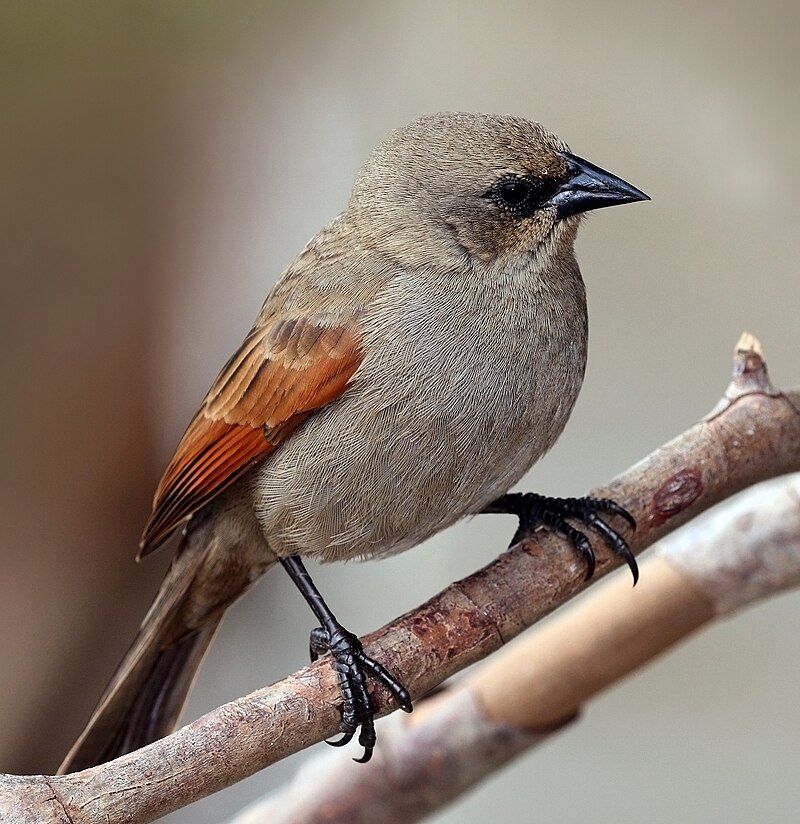
The grayish baywing is a species of bird in the family Icteridae, a group of blackbirds. It was formerly known as the bay-winged cowbird and is currently in the genus Agelaioides.
This is a change from the traditional placement in Molothrus, a genus of cowbirds. The grayish baywing is distinguished by its grayish-brown coloration, with a black head and tail.
It has a distinctive white band that runs across its wings, which helps to identify it from other species in its family. Its diet consists mainly of insects, small fruits, and grains, and it is known to forage in flocks.
The grayish baywing is found in various habitats, from grasslands to forests to urban areas. It is a migratory species in parts of South America, Central America, and the Caribbean.
| Kingdom | Animalia |
| Phylum | Chordata |
| Class | Aves |
| Order | Passeriformes |
| Family | Icteridae |
| Genus | Agelaioides |
| Species | A. badius |
14. Red-gartered Coot
The red-gartered coot is a species of bird that belongs to the subfamily Rallinae, which is part of the family Rallidae. This family includes rails, gallinules, and coots, all waterbirds.
The red-gartered coot can be found in five countries in South America – Argentina, Brazil, Chile, Paraguay, and Uruguay. It is a sedentary bird, meaning it lives in the same area throughout the year and does not migrate.
The red-gartered coot is usually found on shallow lakes, marshes, and flooded grasslands. It feeds mainly on aquatic vegetation, insects, and other small invertebrates.
The red-gartered coot is an essential species in its range, as it provides food for other animals and helps to maintain the balance of the local ecosystem.
| Kingdom | Animalia |
| Phylum | Chordata |
| Class | Aves |
| Order | Gruiformes |
| Family | Rallidae |
| Genus | Fulica |
| Species | F. armillata |
15. White-winged Coot
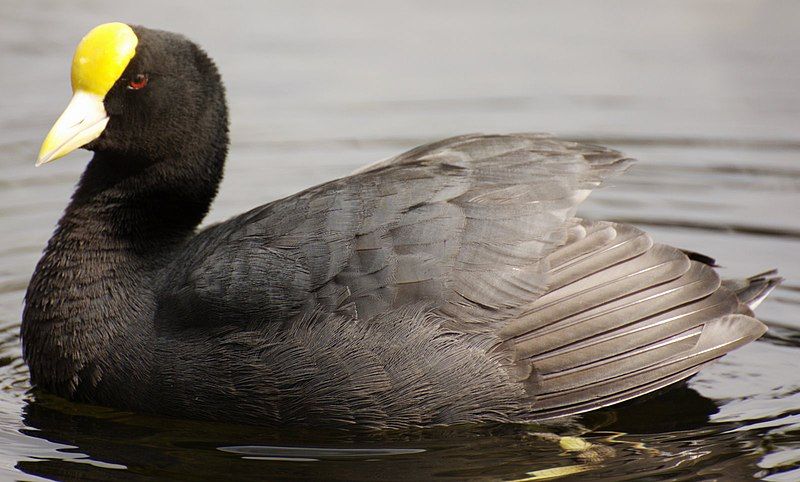
The white-winged coot is a species of bird found in South America and the Falkland Islands. It belongs to the subfamily Rallinae, part of the family Rallidae – a group of birds commonly known as rails, gallinules, and coots.
This bird species can be found in Argentina, Bolivia, Brazil, Chile, Paraguay, Uruguay, and the Falkland Islands. They typically inhabit freshwater wetlands like lakes, ponds, marshes, and swamps.
The white-winged coot has a distinctive black head, white wings, and white-tipped black tail feathers. They also have a white stripe running down the side of their neck and bright yellow legs.
The wings are essential because they enable them to perform swift and decisive flight. The white-winged coot is an omnivorous bird whose diet consists of various small fish, insects, and vegetation.
They often feed in shallow water, and their diet is supplemented by scavenging in aquatic vegetation. These birds are generally solitary and can usually be seen in small groups.
They are known for their loud calls, which are used to communicate with other coots and declare their territory. The white-winged coot is a relatively common species and is considered of most minor concern by the International Union for Conservation of Nature (IUCN).
Despite this, it is still threatened by habitat destruction, pollution, and hunting. Therefore, it is essential to protect their habitats to keep this species from becoming endangered.
| Kingdom | Animalia |
| Phylum | Chordata |
| Class | Aves |
| Order | Gruiformes |
| Family | Rallidae |
| Genus | Fulica |
| Species | F. leucoptera |
16. Cinereous Harrier
The cinereous harrier is a unique species of bird of prey in South America. It is a member of the harrier family known for its impressive range.
This bird breeds in some of the southern parts of the continent, including Tierra del Fuego in the southernmost tip of South America. From there, its range extends through Argentina and Chile and into Bolivia, Paraguay, Peru, and southern Brazil.
The cinereous harrier also crosses the Andes Mountains to reach its northernmost breeding grounds in Colombia. This impressive range gives the cinereous harrier one of the largest breeding ranges of any South American bird of prey.
| Kingdom | Animalia |
| Phylum | Chordata |
| Class | Aves |
| Order | Accipitriformes |
| Family | Accipitridae |
| Genus | Circus |
| Species | C. cinereus |
17. Dark-faced Ground Tyrant
The dark-faced ground tyrant is a small passerine bird from the tyrant flycatcher family. It is a bird species mainly found in the southern Andes region and the Falkland Islands.
This bird species is known to be a ground-dweller, meaning it does not inhabit trees or other upright structures. The dark-faced ground tyrant feeds mainly on small invertebrates, such as flies and moths, which it catches from the ground.
This bird species is known for its remarkable ability to spot its prey from a distance and swoop down quickly to capture it.
The dark-faced ground tyrant is a unique species of bird that is highly adapted to its environment and has a wide range of behaviors that have made it an interesting species to observe and study.
| Kingdom | Animalia |
| Phylum | Chordata |
| Class | Aves |
| Order | Passeriformes |
| Family | Tyrannidae |
| Genus | Muscisaxicola |
| Species | M. maclovianus |
18. Red Shoveler
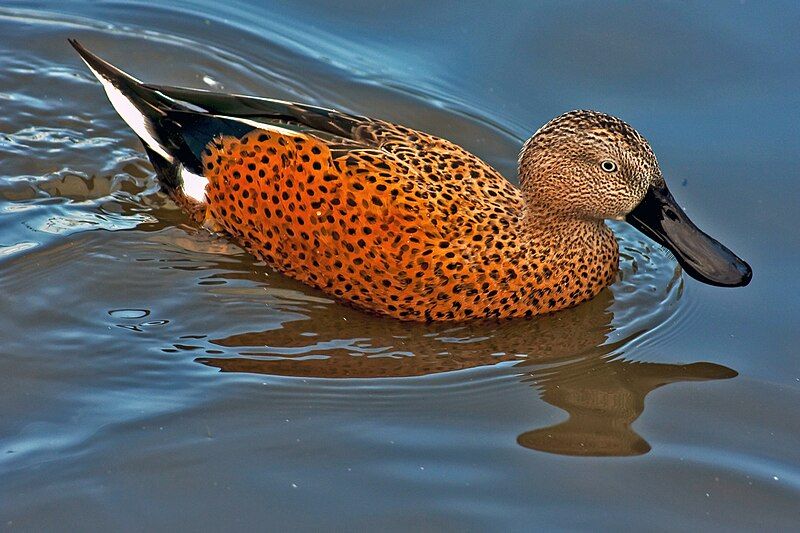
The Red Shoveler is a beautiful species of duck native to South America. This particular species stands out due to its distinct appearance and behavior. It is usually found in open wetlands and marshes, covering most of South America.
The Red Shoveler has a unique body shape sets it apart from other ducks. Its body is long and thin, with a large head and long, curved bill. This bill is an adaptation that helps it feed from the muddy waters of its native habitat.
The Red Shoveler has a reddish-brown body with white wings, back, and belly. Its head is black, with a white stripe running down its neck. The Red Shoveler is a dabbling duck, meaning it feeds in shallow water, scooping food with its bill.
Its diet consists mainly of aquatic insects, mollusks, crustaceans, seeds, and other plant material. The Red Shoveler is also known to eat small fish and amphibians. The Red Shoveler is a social species, often seen in flocks of other duck species.
During breeding season, it forms pairs and engages in elaborate courtship displays. The female builds a nest on the ground, usually near water, and lays a clutch of 6 to 12 eggs. The female will incubate the eggs for about 25 days, and both parents will care for the young.
The Red Shoveler is a unique species of duck well-adapted to its environment. Its distinct body shape and coloration help it to stand out among its peers, and its social behavior and specialized diet make it an interesting species to study.
| Kingdom | Animalia |
| Phylum | Chordata |
| Class | Aves |
| Order | Anseriformes |
| Family | Anatidae |
| Genus | Spatula |
| Species | S. platalea |
19. Scale-throated Earthcreeper
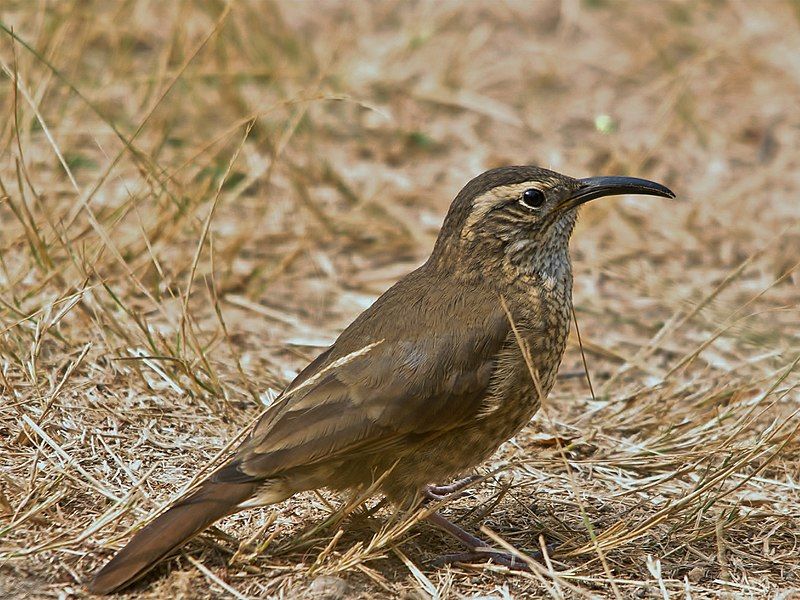
The scale-throated earthcreeper is a bird species belonging to the Furnariidae family. It is native to Argentina, Chile, and the Altiplano.
During the winter, it migrates to the Pampas, an area of extended plains in Argentina, and to the east of Córdoba, a province of Argentina.
The scale-throated earthcreeper is a small bird with a distinctive scaly pattern on its throat, which gives it its name. It is mainly brown with a whitish underside and has black stripes on its wings.
It feeds on insects and other invertebrates and is typically found in open grasslands and dry shrubland. The scale-throated earth creeper has a wide distribution across the continent of South America, but its population numbers are decreasing due to the destruction of its habitat.
Therefore, it is considered vulnerable by the International Union for Conservation of Nature (IUCN) and is listed on the IUCN Red List of Threatened Species. Conservation efforts are being made to protect this species and its natural habitat.
| Kingdom | Animalia |
| Phylum | Chordata |
| Class | Aves |
| Order | Passeriformes |
| Family | Furnariidae |
| Genus | Upucerthia |
| Species | U. dumetaria |
20. Grey-bellied Shrike-tyrant
The Grey-bellied Shrike-Tyrant is a species of bird in the Tyrannidae family, a group of passerine birds. It has a unique appearance, with its plumage being mainly grey and its underside being a lighter shade of grey.
It is also relatively large compared to other birds, measuring 24-25.5 cm long. The Grey-bellied Shrike-Tyrant is native to South America, specifically Argentina, Bolivia, Chile, Paraguay, Peru, and Uruguay.
It prefers open habitats such as grasslands and savannas, where it can easily find food sources like insects, tiny frogs, and lizards.
It is usually seen perched on a low bush or tree, and when disturbed, it will take off in flight and often land a short distance away. The Grey-bellied Shrike-Tyrant is a solitary bird that breeds during the spring and summer months.
During this time, it builds a nest in a tree, usually close to the trunk.
It is a very vocal bird and can be heard making loud calls and songs, which it uses to mark its territory and attract mates. The Grey-bellied Shrike-Tyrant is a common species, and its population is stable.
It is not currently listed as threatened on the IUCN Red List, indicating that its population is not in immediate danger.
| Kingdom | Animalia |
| Phylum | Chordata |
| Class | Aves |
| Order | Passeriformes |
| Family | Tyrannidae |
| Genus | Agriornis |
| Species | A. micropterus |
21. Yellow-winged Blackbird
The Yellow-winged Blackbird is a type of bird that belongs to the Icteridae family. It is commonly found in South American countries such as Argentina, Bolivia, Brazil, Chile, Paraguay, Peru, and Uruguay.
This bird species prefers to inhabit swamps, intertidal marshes, and pastureland. These habitats provide a safe place for them to build nests and look for food. They are usually found in small groups but can also be seen alone.
The Yellow-winged Blackbird is an omnivore, eating both plants and insects. They can survive in various environments, making them a very adaptable bird species.
| Kingdom | Animalia |
| Phylum | Chordata |
| Class | Aves |
| Order | Passeriformes |
| Family | Icteridae |
| Genus | Agelasticus |
| Species | A. thilius |
22. Mourning sierra Finch
The mourning sierra finch is a unique bird species native to South America. It belongs to the tanager family Thraupidae and is the only member of the genus Rhopospina. This species is typically found in Argentina, Bolivia, Chile, and Peru.
It also appears in the Falkland Islands and Brazil, although it does not typically breed or live there. The mourning Sierra finch is a medium-sized bird with a grayish-brown back, head, and slightly paler belly.
Its wings are blackish-brown with white or cream-colored markings. It also has a distinctive black tail with a white patch at the tip. The male’s throat and breast are a brig, rusty-red color. The females are a pale shade.
This species feeds mainly on insects but will eat small fruits and seeds. It is a social bird and can often be seen in flocks of up to ten birds. It is an active bird and can often be seen foraging in the trees and shrubs for food.
The mourning Sierra finch is a vocal bird, and its song is a series of melodic notes that can be heard from some distance.
The mourning Sierra finch is an essential species in its native range, providing food for other bird species and helping to disperse seeds and other plant material.
It is also an important indicator species, as its presence or absence can be used to determine the health of the surrounding habitat. Despite this, its population is declining due to habitat loss and degradation.
This is why it is essential to protect its natural habitat and ensure its needs are met.
| Kingdom | Animalia |
| Phylum | Chordata |
| Class | Aves |
| Order | Passeriformes |
| Family | Thraupidae |
| Genus | Rhopospina |
| Species | R. fruticeti |
23. Black-headed Duck
The black-headed duck is a species of duck found in South America. It belongs to the subfamily Oxyurinae, which is part of the family Anatidae, which includes various waterfowl such as ducks, geese, and swans.
These ducks are native to Argentina, Bolivia, Brazil, Chile, Paraguay, and Uruguay. They have a black head and neck, a white breast and belly, and grey wings. The male has a white stripe on the side of his head, while the female is plainer in appearance.
The black-headed duck is an omnivore, feeding on various aquatic plants, insects, larvae, and mollusks. These ducks live in freshwater marshes, rivers, and lakes but can also be found near estuaries and saltwater lagoons.
They are social birds, often forming large flocks with other waterfowl. During the breeding season, these birds form monogamous pairs, and the male will perform a courtship display to attract a mate.
The female black-headed duck builds a nest close to the water and usually lays around six to eight eggs. The chicks can fly after six weeks. The black-headed duck is listed as the least Concerned on the IUCN Red List of Threatened Species, and their population is stable.
| Kingdom | Animalia |
| Phylum | Chordata |
| Class | Aves |
| Order | Anseriformes |
| Family | Anatidae |
| Genus | Heteronetta |
| Species | H. atricapilla |
24. Common Miner
The Common Miner is a species of bird that belongs to the subfamily Sclerurinae, which is part of the ovenbird family Furnariidae. This bird is widely distributed in South America and is found in Argentina, Bolivia, Brazil, Chile, Peru, and Uruguay.
Common Miners are passerines, meaning they have relatively short and powerful beaks, which they use to catch insects and other small animals.
They also feed on various seeds and fruits and are known for ‘leaf-tossing’ or flipping leaves to uncover insects underneath. Their bodies are small and slender, with predominantly brown plumage varying depending on their location.
Common Miners are known to nest in tree cavities and can often be found in large flocks, foraging together in open areas such as meadows and grasslands.
| Kingdom | Animalia |
| Phylum | Chordata |
| Class | Aves |
| Order | Passeriformes |
| Family | Furnariidae |
| Genus | Geositta |
| Species | G. cunicularia |
25. Black-chinned Siskin
The black-chinned siskin is a finch species belonging to the family Fringillidae. This species can be found in various places, including Argentina, Chile, and the Falkland Islands.
The black-chinned siskin is adapted to living in temperate and heavily degraded former forests.
The temperate forests provide the siskin with various food sources, such as seeds and fruit, while the former forests offer a range of insects and other invertebrate prey.
The black-chinned siskin can also capitalize on the resources found in open areas, such as farmlands and gardens. The species’ adaptability helps ensure its continued survival in its natural habitats.
| Kingdom | Animalia |
| Phylum | Chordata |
| Class | Aves |
| Order | Passeriformes |
| Family | Fringillidae |
| Genus | Spinus |
| Species | S. barbatus |
26. Red-fronted Coot
The red-fronted coot is a species of bird belonging to the subfamily Rallinae, which is part of the bird family Rallidae. This family is composed of rails, gallinules, and coots.
These birds are typically found in South America, and the red-fronted coot is known to be present in Argentina, Bolivia, Brazil, Chile, Peru, and Uruguay.
This bird species is usually seen in shallow wetlands, such as ponds, marshes, and lakes, and they are also often found along the edges of rivers. They have black plumage and a distinctive red patch on the forehead, which is how they get their name.
The red-fronted coot feeds on aquatic plants, grasses, and small invertebrates and is active throughout the day. They form large flocks of up to several hundred birds during winter and mi, grate southward for the breeding season.
Red-fronted coots are typically quite shy birds, a widespread species among birdwatchers.
| Kingdom | Animalia |
| Phylum | Chordata |
| Class | Aves |
| Order | Gruiformes |
| Family | Rallidae |
| Genus | Fulica |
| Species | F. rufifrons |
27. Spot-flanked Gallinule
The Spot-flanked Gallinule is a unique species of bird belonging to the family Rallidae. It is the sole species in the genus Porphyriops and is found in several countries across South America, including Argentina, Bolivia, Brazil, Chile, Colombia, Paraguay, Peru, and Uruguay.
This bird species inhabits swamps and freshwater lakes, making these its natural habitat. The Spot-flanked Gallinule is a mid-sized bird aged between 30 and 35 cm. Its plumage is primarily grey, with a white spot on the body.
It has a yellow bill, red eyes, and brown legs and feet. Its diet consists of various insects, crustaceans, and aquatic plants. The Spot-flanked Gallinule is a highly social bird, forming flocks of up to one hundred individuals.
It is also known to form mixed-species flocks with other birds, such as herons, bitterns, and ducks. It is a vocal species, producing various chirps, whistles, and clicks.
Breeding season occurs mainly during the summer months, and the female will lay a clutch of three to five eggs in a nest made of vegetation. Overall, the Spot-flanked Gallinule is an exciting bird species found in several countries across South America.
It inhabits swamps and freshwater lakes, making these its natural habitats. It is a social bird that is known to form large flocks, and it is also a vocal species. Breeding season occurs during summer, and the female will lay a clutch of three to five eggs.
| Kingdom | Animalia |
| Phylum | Chordata |
| Class | Aves |
| Order | Gruiformes |
| Family | Rallidae |
| Genus | Porphyriops |
| Species | P. melanops |
28. Tufted Tit-tyrant
The Tufted Tit-Tyrant is a species of bird that belongs to the family Tyrannidae, commonly referred to as the tyrant flycatchers. It is frequently found in western South America, stretching from Colombia in the north to Tierra del Fuego in the south.
The species is widespread in the Andes mountain range, where its range covers the entire mountain chain. This bird species is relatively small, with a body length of 15 and 16 centimeters.
Its plumage is predominantly grey but is also characterized by two distinct tufts of feathers on its head, which give it its name.
In addition to its grey plumage, it also has a black bill and white wing patches. The Tufted Tit-Tyrant is known to inhabit various habitats, including open and forested areas.
It typically feeds on insects but takes other small food items, such as spiders and berries.
It is generally found in pairs and is known to be a territorial species, aggressively defending its territory from intruders. The Tufted Tit-Tyrant is a fascinating species of bird and one that is well worth observing in its native habitat.
With its distinct tufts and grey plumage, it is a species that is sure to capture the attention of birdwatchers.
| Kingdom | Animalia |
| Phylum | Chordata |
| Class | Aves |
| Order | Passeriformes |
| Family | Tyrannidae |
| Genus | Anairetes |
| Species | A. parulus |
29. White-winged Black Tyrant
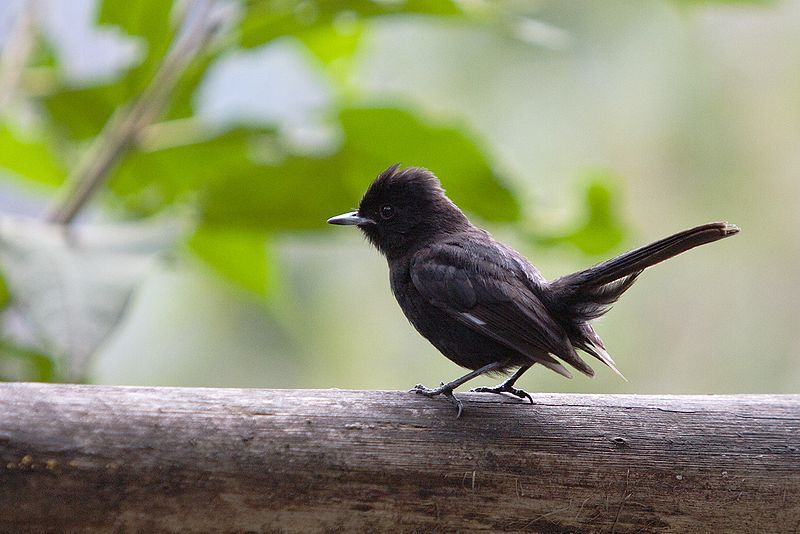
The white-winged black tyrant is a species of bird belonging to the family Tyrannidae, which includes a variety of other tyrant flycatchers. This species is typically found in countries across South America, including Argentina, Bolivia, Chile, Paraguay, Peru, and Uruguay.
It has often been considered to include the Sao Francisco black tyrant as a subspecies. However, some researchers have argued that it should be considered a separate species. The white-winged black tyrant is a medium-sized bird, measuring up to 7 inches long.
It has a blackish body with a white patch on its wings and tail. Its head is black, and its beak is yellow. Its legs and feet are greyish. The white-winged black tyrant prefers dry, open habitats like scrublands and grasslands.
Its diet consists mainly of insects, which it catches in mid-air. It also eats small amounts of fruit, seeds, and berries. During the breeding season, the male will sing to attract a mate, and the pair will build a nest in a tall tree or shrub.
The white-winged black tyrant is classified as a species of most minor concern by the International Union for Conservation of Nature. It is not endangered, and its population is stable.
However, its population has declined in some areas due to habitat destruction and other human activities. Protecting this species’ habitat and other birds’ habitats is essential to ensure their continued survival.
| Kingdom | Animalia |
| Phylum | Chordata |
| Class | Aves |
| Order | Passeriformes |
| Family | Tyrannidae |
| Genus | Knipolegus |
| Species | K. aterrimus |
30. White-banded Mockingbird
The white-banded mockingbird is a species of bird that belongs to the Mimidae family, an influential group of birds that includes the iconic mockingbirds and thrashers.
This species is found in many parts of South America, including Argentina, Bolivia, Brazil, Chile, Paraguay, and Uruguay. It is a medium-sized, slender bird that sports a distinctive white band on its chest.
Its upperparts are mostly grey-brown, while its underparts are pale grey. The white-banded mockingbird is an insectivore that feeds on a variety of insects. Additionally, it also eats fruits and berries from trees and shrubs.
It can be found in various habitats, from humid lowland forests to dry scrubland and suburban areas. This species is known for its loud, melodic songs that can be heard throughout its range. It is a vocal species, often singing both day and night.
Its song consists of various musical notes that can be pretty complex. It also has a unique call often heard early before sunrise.
The white-banded mockingbird is an essential species in its range as it helps maintain the ecosystem’s balance. It is a territorial species and will often defend its territory against other birds.
It is also an important food source for many predators, such as hawks and owls. Overall, the white-banded mockingbird is an important species in the habitats it inhabits. Its presence helps keep the environment balanced and provides essential animal food sources.
Its beautiful song is also a delight to listen to and adds to the natural world’s beauty.
| Kingdom | Animalia |
| Phylum | Chordata |
| Class | Aves |
| Order | Passeriformes |
| Family | Mimidae |
| Genus | Mimus |
| Species | M. triurus |
31. Screaming Cowbird
The screaming cowbird is a species of bird belonging to the family Icteridae, which is native to South America. It is also known by its more common name, the short-billed cowbird.
This bird species is an obligate brood parasite, meaning that it lays its eggs in the nests of other species of birds, and the host species then raises the cowbird young as its own.
This behavior benefits the screaming cowbird, as they do not need to expend energy and resources to care for their young.
The screaming cowbird is unusual because it does not build its own nest or care for its young but relies on the hosts. This bird species has a short, stout bill, which is the basis of its common name.
The screaming cowbird is also known for its loud, often harsh calls, which can be heard over long distances.
| Kingdom | Animalia |
| Phylum | Chordata |
| Class | Aves |
| Order | Passeriformes |
| Family | Icteridae |
| Genus | Molothrus |
| Species | M. rufoaxillaris |
32. White-tipped Plantcutter
The white-tipped plantcutter is a species of bird belonging to the family Cotingidae. This family of birds, sometimes referred to as the plant cutters, is known for its distinct sexual dimorphism, meaning that males and females of the species look different from one another.
Additionally, the family is characterized by its folivorous diet, meaning it primarily feeds on leaves. This bird species is found widely within the woodland and scrub of southeastern and south-central South America.
It is found in various habitats, including grasslands, wetlands, and mountain rainforests. The white-tipped plantcutter is a large bird, measuring up to 24cm long. It has a distinctive white patch on its forehead, where it gets its name.
The bird is usually observed alone or in small groups and primarily feeds on insects, fruits, and leaves.
This species is an important seed disperser in its range, as it has been known to carry the seeds of various plants in its feathers when it flies from one place to another.
| Kingdom | Animalia |
| Phylum | Chordata |
| Class | Aves |
| Order | Passeriformes |
| Family | Cotingidae |
| Genus | Phytotoma |
| Species | P. rutila |
33. Brown-chested Martin
The brown-chested martin is a type of songbird belonging to the swallow family. This species is commonly found in South America, from Argentina to French Guiana.
They inhabit various countries and territories, including Bolivia, Brazil, Chile, Colombia, Costa Rica, Ecuador, Guyana, Panama, and Paraguay. These birds are usually found near rivers, streams, and wetlands.
They are highly social and form large flocks of up to one hundred birds. They feed mainly on flying insects, which they catch in mid-air. Brown-chested martins often nest in colonies and build their nests in rock crevices or tree hollows.
Brown-chested martins are small birds with glossy blue-black upperparts and chestnut-brown breasts. The underside of their wings is predominantly white, and they have a short forked tail, which they often flick up and down while in flight.
They are relatively easy to identify due to their distinctive call and loud, sharp ‘trip’ notes. The brown-chested martin is a widespread species found across much of South America.
It is an integral part of the local ecosystem, helping to keep insect populations in check and providing food for other animals.
| Kingdom | Animalia |
| Phylum | Chordata |
| Class | Aves |
| Order | Passeriformes |
| Family | Hirundinidae |
| Genus | Progne |
| Species | P. tapera |
34. White-throated Cacholote
The white-throated cacholote is a small bird belonging to the Furnariidae family. This species is native to Argentina and prefers to live in dry subtropical or tropical shrubland habitats.
These habitats are characterized by relatively low levels of rainfall and the presence of shrubs, small trees, and other woody plants adapted to survive in such areas.
These habitats are usually found near rivers, lakes, or other areas with permanent water sources. The white-throated cacholote typically forages for food on the ground and feeds on various insects, fruits, and seeds.
It has a distinctive white throat and is easily identified from other species in the same family. This species is considered to be of the most minor concern by the IUCN, and its conservation status is stable.
| Kingdom | Animalia |
| Phylum | Chordata |
| Class | Aves |
| Order | Passeriformes |
| Family | Furnariidae |
| Genus | Pseudoseisura |
| Species | P. gutturalis |
35. Patagonian Yellow Finch
The Patagonian yellow finch is a unique species of bird found in the Thraupidae family. It is native to Argentina, Tierra del Fuego, and Chile. It prefers to live in dry shrublands or temperate grasslands with plenty of food and shelter.
The Patagonian yellow finch is a small bird, usually between four and five inches long. It has a yellow body with a black beak, and the wings are pale blue. The feathers on its belly are a bright yellow, and its tail feathers are a darker yellow.
It mainly feeds on small insects and seeds and can often be seen hopping around in search of food. The Patagonian yellow finch is an integral part of its natural habitat and plays a vital role in the ecosystem.
It helps to keep the numbers of harmful insects in check and helps to spread the seeds of various plants. As such, we need to protect these birds and their habitats so that they can continue to play an essential role in the environment.
| Kingdom | Animalia |
| Phylum | Chordata |
| Class | Aves |
| Order | Passeriformes |
| Family | Thraupidae |
| Genus | Sicalis |
| Species | S. lebruni |
36. Chilean Swallow
The Chilean Swallow is a species of bird belonging to the Hirundinidae family, which includes other species of swallows.
This species breeds in Chile and Patagonia but also migrates during certain times of the year, traveling north as far as Bolivia, Paraguay, and Rio Grande do Sul.
During the migratory season, these birds can be found in the locations above and other parts of South America. The Chilean Swallow has distinctive plumage, a dark grayish-brown back, wings, and a white belly.
It has a forked tail, which helps it to maneuver and change direction quickly when flying. The bird’s diet consists of insects, which it catches in flight. The Chilean Swallow is considered to be a pretty common species, and it is not currently threatened.
Nevertheless, its population is declining due to habitat loss. As humans encroach upon its natural habitat, these birds must look for new places to breed and feed. As a result, their numbers are decreasing.
This is why protecting this species and its natural habitat is essential.
| Kingdom | Animalia |
| Phylum | Chordata |
| Class | Aves |
| Order | Passeriformes |
| Family | Hirundinidae |
| Genus | Tachycineta |
| Species | T. leucopyga |
37. Grassland Yellow Finch
The Grassland Yellow Finch is a small passerine bird. Despite its name, it is not a finch but rather a seedeater. This bird, alongside buntings and American sparrows, was part of the Emberizidae family. This family is now known to be tanagers.
The Grassland Yellow Finch is a member of the Tanager family, which includes over 250 species of birds. They are mainly found in tropical and subtropical regions of the world and vary in size, color, and behavior.
The Grassland Yellow Finch is a small bird with yellow feathers and a short, stout bill. It feeds mainly on seeds, which it consumes from the ground. The Grassland Yellow Finch was formerly united with buntings and American sparrows in the Emberizidae family.
This family is now a part of the Tanager family, which suggests that the Grassland Yellow Finch is closely related to these birds. The Tanager family is divided into two subfamilies, the Thraupinae and the Emberizinae.
The Grassland Yellow Finch is part of the Emberizinae subfamily, which consists of small to medium-sized birds that feed mainly on seeds. The grassland yellowfinch is an essential species in its ecosystem, as its diet of seeds helps disperse the seeds of various plant species.
This helps to ensure the survival of these plant species and the health of the grasslands in which the Grassland Yellow Finch lives.
The Grassland Yellow Finch is an important food source for many animals, including hawks, owls, and other birds. The Grassland Yellow Finch is a fascinating bird, and its importance in its ecosystem is undeniable.
It is a species that has been united with buntings and American sparrows in the past and is now an essential part of the Tanager family. This bird plays a vital role in its environment, and its presence is critical to the health of the grasslands it inhabits.
| Kingdom | Animalia |
| Phylum | Chordata |
| Class | Aves |
| Order | Passeriformes |
| Family | Thraupidae |
| Genus | Sicalis |
| Species | S. luteola |
Conclusion
Birds in Chubut Province are a great source of biodiversity and a vital component of the local ecosystem. The variety of species in the area is impressive and provides an excellent opportunity for bird watching, photography, and research.
It is essential to continue monitoring the birds’ bird population in Chubut Province to ensure their continued health and abundance.